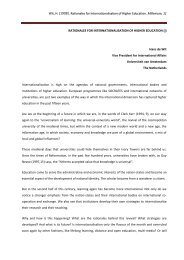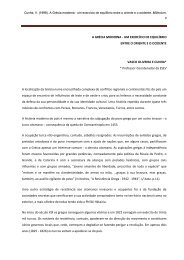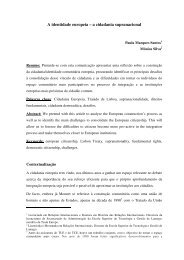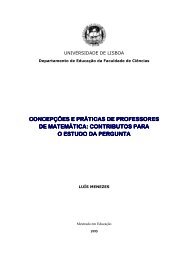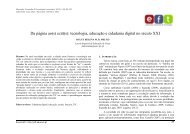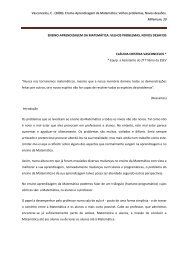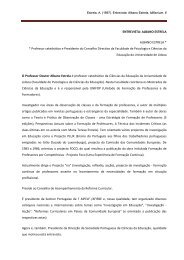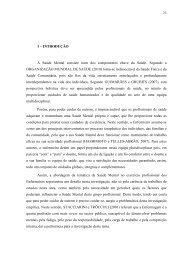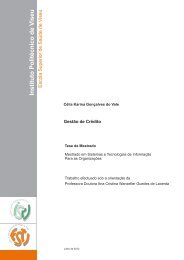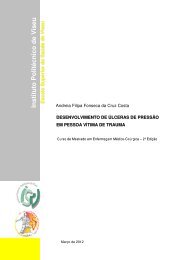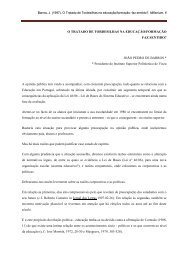644 Eur Food Res Technol (2011) 233:637–646increase in the relative content <strong>of</strong> Val <strong>and</strong> Ala was alsoobserved in traditional, GH1 <strong>and</strong> GH2 processed fruits.Detection <strong>of</strong> carboxymethyllysine (CML),carboxyethyllysine (CEL) <strong>and</strong> furosine in <strong>pears</strong>In order to observe whether the browning <strong>of</strong> <strong>sun</strong>-<strong>dried</strong><strong>pears</strong> also results from the contribution <strong>of</strong> <strong>Maillard</strong> reactionproducts, the analysis <strong>of</strong> carboxymethyllysine (CML),carboxyethyllysine (CEL) <strong>and</strong> furosine in <strong>dried</strong> <strong>pears</strong> wassearched <strong>and</strong> fresh <strong>pears</strong> were also analysed to be used ascontrol. CML quantification was performed together withCEL due to the fact that the applied methodology does notallow the separation between these two <strong>compounds</strong>.Although literature does not report the occurrence <strong>of</strong>furosine, CML <strong>and</strong> CEL in unprocessed materials usingthis methodology, it was noticed their occurrence in fresh<strong>pears</strong>. In fact, furosine content detected for fresh <strong>pears</strong> was871 mg per 100 g <strong>of</strong> protein present in the sample <strong>and</strong> theamount <strong>of</strong> CEL ? CML detected was 275 mg 100 g -1protein. Some authors [29, 30] reported that this kind <strong>of</strong><strong>compounds</strong> might partially be formed from degradationproducts derived from lipids or sugars during samplehydrolysis. As these fruits have not been processed, theoccurrence <strong>of</strong> these <strong>compounds</strong> may be resultant <strong>of</strong> anartefact <strong>of</strong> the methodology used, namely from the <strong>acid</strong>hydrolysis to which the samples were submitted. In order toavoid this fact, a preliminary protein extraction would berequired to remove all interferences in the analysis methodology.Nevertheless, the amount <strong>of</strong> furosine <strong>and</strong>CML ? CEL was higher in <strong>dried</strong> samples. Using fresh<strong>pears</strong> as control <strong>of</strong> the methodology applied, it was possibleto determine the amount <strong>of</strong> these <strong>compounds</strong> producedafter the different drying technologies used (Fig. 4).For <strong>dried</strong> <strong>pears</strong>, furosine amount ranged between247 mg 100 g -1 protein for traditional <strong>and</strong> 80 mg 100 g -1protein for HAT. For GH1 <strong>and</strong> GH2, the furosine amountwas 182 <strong>and</strong> 136 mg 100 g -1 proteins, respectively. Theamount <strong>of</strong> furosine detected for <strong>dried</strong> <strong>pears</strong> was similar tothat described in literature for products to which moderateContent (mg / 100 g Protein)300250200150100500Fur CML+CEL Fur CML+CEL Fur CML+CEL Fur CML+CELTraditional GH1 GH2 HATFig. 4 Furosine (Fur) <strong>and</strong> carboxymethyllysine (CML) ? carboxyethyllysine(CEL) content (mg 100 g -1 protein) in <strong>dried</strong> <strong>pears</strong>from 2009 harvestheat treatment is applied, such as UHT milk products [31,32] (35–269 mg 100 g -1 protein), jams <strong>and</strong> fruit-basedinfant foods [18] (44–448 mg 100 g -1 protein) <strong>and</strong> cookedbeef <strong>and</strong> salmon [29] (100–200 mg 100 g -1 protein). ForCML ? CEL quantification in <strong>dried</strong> <strong>pears</strong>, the amount <strong>of</strong>these <strong>compounds</strong> ranged between 96 mg 100 g -1 proteinfor traditional <strong>and</strong> 37 mg 100 g -1 protein for HAT. ForGH1 <strong>and</strong> GH2, the furosine amount was 94 <strong>and</strong> 71 mg100 g -1 proteins, respectively. The values determined forthe content <strong>of</strong> CML ? CEL in <strong>dried</strong> <strong>pears</strong> were, asexpected, higher compared to those described in literaturefor CML even in severely heat-treated foods, such assterilised evaporated milk [17] (43–52 mg 100 g -1 protein)<strong>and</strong> hypoallergenic powdered infant formulas [30](13–32 mg 100 g -1 protein). This fact may be due to CELinterference in CML quantification.In both analysis (furosine <strong>and</strong> CML ? CEL), there wasa tendency for the occurrence <strong>of</strong> higher levels <strong>of</strong> these<strong>compounds</strong> in traditional <strong>pears</strong> <strong>and</strong> lower contents in HAT<strong>dried</strong> <strong>pears</strong>, while GH1 <strong>and</strong> GH2 <strong>dried</strong> <strong>pears</strong> presentedintermediate levels (Fig. 4), showing that the traditionalwas the most severe processing <strong>of</strong> all studied <strong>and</strong> the HATwas the less severe.Taking into account the amount <strong>of</strong> the decrease in thecontent <strong>of</strong> each amino <strong>acid</strong> with the different treatments(Table 2) <strong>and</strong> the amounts <strong>of</strong> <strong>Maillard</strong> reaction productsquantified (Fig. 4), it is possible to observe a positivecorrelation between the contents <strong>of</strong> these <strong>compounds</strong> <strong>and</strong>the decrease in the relative amount <strong>of</strong> Lys <strong>and</strong> Phe. On thecontrary Val, Ala, Ile <strong>and</strong> Glx showed a negative correlation.The decrease in the relative content <strong>of</strong> Pro does notshow any relation with the occurrence <strong>of</strong> these <strong>compounds</strong>.The Lys degradation observed in Traditional <strong>and</strong> GH1<strong>pears</strong> is comparable to that occurring in condensed milk butis lower than that <strong>of</strong> chocolate, processed breakfast cereals<strong>and</strong> bread [33] <strong>and</strong> fruits <strong>and</strong> vegetables in baby foods [34],which allows to include the <strong>pears</strong> in moderate thermallyprocessed foods if processed according to the traditionalprocess or with GH1. Using this parameter as marker <strong>of</strong> thethermal damage [11, 13, 35], it can be stated that the <strong>pears</strong>produced by HAT do not lose the nutritional value concerningthe stability <strong>of</strong> Lys. However, <strong>Maillard</strong> reactionproducts, when in a moderate amount as observed in traditional<strong>and</strong> GH1 <strong>pears</strong>, may contribute to beneficial antioxidantproperties [36, 37].The differences observed between the colour <strong>of</strong> traditional<strong>pears</strong> (reddish brown colour) <strong>and</strong> HAT <strong>dried</strong> <strong>pears</strong>(yellow-orange colour) are also in accordance with thehigher amount <strong>of</strong> <strong>Maillard</strong> reaction products in traditionalprocessed fruits. For GH1 <strong>and</strong> GH2 <strong>dried</strong> <strong>pears</strong>, the colourationwas similar to the traditional <strong>dried</strong> <strong>pears</strong>, althoughGH2 fruits presented a not so intense colour as traditional<strong>and</strong> GH1 ones (Fig. 1). These results allow to infer that the123
Eur Food Res Technol (2011) 233:637–646 645drying process promotes the occurrence <strong>of</strong> <strong>Maillard</strong> reactionsin the S. Bartolomeu <strong>pears</strong> <strong>and</strong> that in the traditional,GH1, <strong>and</strong> GH2 drying processes, they contribute to thereddish brown colour <strong>of</strong> the <strong>dried</strong> <strong>pears</strong>. For HAT drying, itis possible that the heating <strong>of</strong> the fruits has not been highenough to promote the occurrence <strong>of</strong> <strong>Maillard</strong> reactions inthe most advanced steps, when the brown colouration isproduced.Influence <strong>of</strong> pH, temperature <strong>and</strong> moisture on <strong>dried</strong>pear colour formationAs the <strong>Maillard</strong> reaction is known to be favoured duringthe dehydration process systems [13] under conditions <strong>of</strong>pH ranging 5–7, with intermediate moisture content <strong>and</strong>temperatures over 50 °C using long processing times, a fewsets <strong>of</strong> simple experiments were performed on pear tissuesto relate the occurrence <strong>of</strong> <strong>Maillard</strong> <strong>compounds</strong> with thereddish brown colouration.In order to test the influence <strong>of</strong> pH on the development<strong>of</strong> the colour <strong>of</strong> the <strong>pears</strong>, pieces <strong>of</strong> freeze-<strong>dried</strong> pulp <strong>of</strong> afresh pear were immersed in buffer solutions in the range<strong>of</strong> the pH scale. It was observed that the tissues immersedin the solutions with higher pH became darker than theother ones. The major colour variations were observed inthe interval <strong>of</strong> pH 4–6, whereas at pH 5.0, the colour <strong>of</strong> thetissue approached the reddish brown colour characteristic<strong>of</strong> the traditional product (Fig. 5a).abclowmoisturepH 4 pH 5 pH 6<strong>sun</strong>lightdarkness30 °C 50 °ChighmoisturehighmoistureFig. 5 Effect <strong>of</strong> a pH variation, b <strong>sun</strong>light exposure <strong>and</strong> c moisture<strong>and</strong> temperature in the development <strong>of</strong> the colour <strong>of</strong> pear tissuesThe freeze-<strong>dried</strong> pear tissues that have been immersed inthe buffer solution at pH 5.0 were placed (in a wet form) intwo plastic containers, one exposed to <strong>sun</strong>light <strong>and</strong> theother one was placed in the dark. This experiment allowedto observe that the sample exposed to <strong>sun</strong>light presented anincrease in the intensity <strong>of</strong> the colour when compared withthe sample placed in the dark (Fig. 5b). Because watercondensation was observed over the walls <strong>of</strong> the containerswhere the tissues were exposed to the light <strong>and</strong> not in thecontrol ones, it was hypothesised that the increase intemperature <strong>of</strong> the wet tissues could be an important factorfor pear tissues colouration. To test this hypothesis, pieces<strong>of</strong> freeze-<strong>dried</strong> pear tissues were immersed in the buffersolution at pH 5.0 <strong>and</strong> the wet material was cut in twohalves. One part was placed in a Petri dish that was closedto preserve the moisture <strong>and</strong> the other one was left in directcontact with the air. Both samples were placed in an ovenat 30 <strong>and</strong> 50 °C. It was observed that the tissues that weremaintained closed, keeping the moisture, presented moreintense colourations <strong>and</strong> the colour intensity was higher for50 °C than for 30 °C (Fig. 5c).These results allow concluding that the pH, the dryingtemperature <strong>and</strong> the tissues moisture are importantparameters for the development <strong>of</strong> the characteristic colour<strong>of</strong> the traditional product.ConclusionThe results obtained allowed concluding that drying <strong>of</strong>S. Bartolomeu <strong>pears</strong> affects the free amino <strong>acid</strong> <strong>pr<strong>of</strong>ile</strong>,increasing Pro content <strong>and</strong> decreasing Asx <strong>and</strong> Glx.Although the proteic amino <strong>acid</strong> <strong>pr<strong>of</strong>ile</strong> was not significantlymodified with the drying process, a loss <strong>of</strong> therelative content <strong>of</strong> Lys is observed. This loss is related withthe increase in the amount <strong>of</strong> furosine, CML <strong>and</strong> CELformed during the drying process.Although all drying methods tested promoted theincrease in the amount <strong>of</strong> CML, CEL <strong>and</strong> furosine, thisincrease was higher in the case <strong>of</strong> the traditional <strong>sun</strong>-drying<strong>and</strong> greenhouse processing, where the fruits presentedreddish brown colour <strong>and</strong> lower for the hot air tunnelprocessing, where the fruits became yellow-orange. Theseresults allow to conclude that the drying processing <strong>of</strong>S. Bartolomeu <strong>pears</strong> promotes <strong>Maillard</strong> reactions, possiblycontributing to the characteristic reddish brown colour <strong>of</strong>this product. These reactions are formed under conditions<strong>of</strong> pH, temperature <strong>and</strong> moisture that promote the development<strong>of</strong> this characteristic colour.Acknowledgments We thank FCT for financial support throughproject PTDC/AGR-ALI/74587/2006, Research Unit 62/94-QOPNA(PEst-C/QUI/UI0062/2011) <strong>and</strong> Cláudia Nunes Post-Doc grantSFRH/BPD/46584/2008.123




